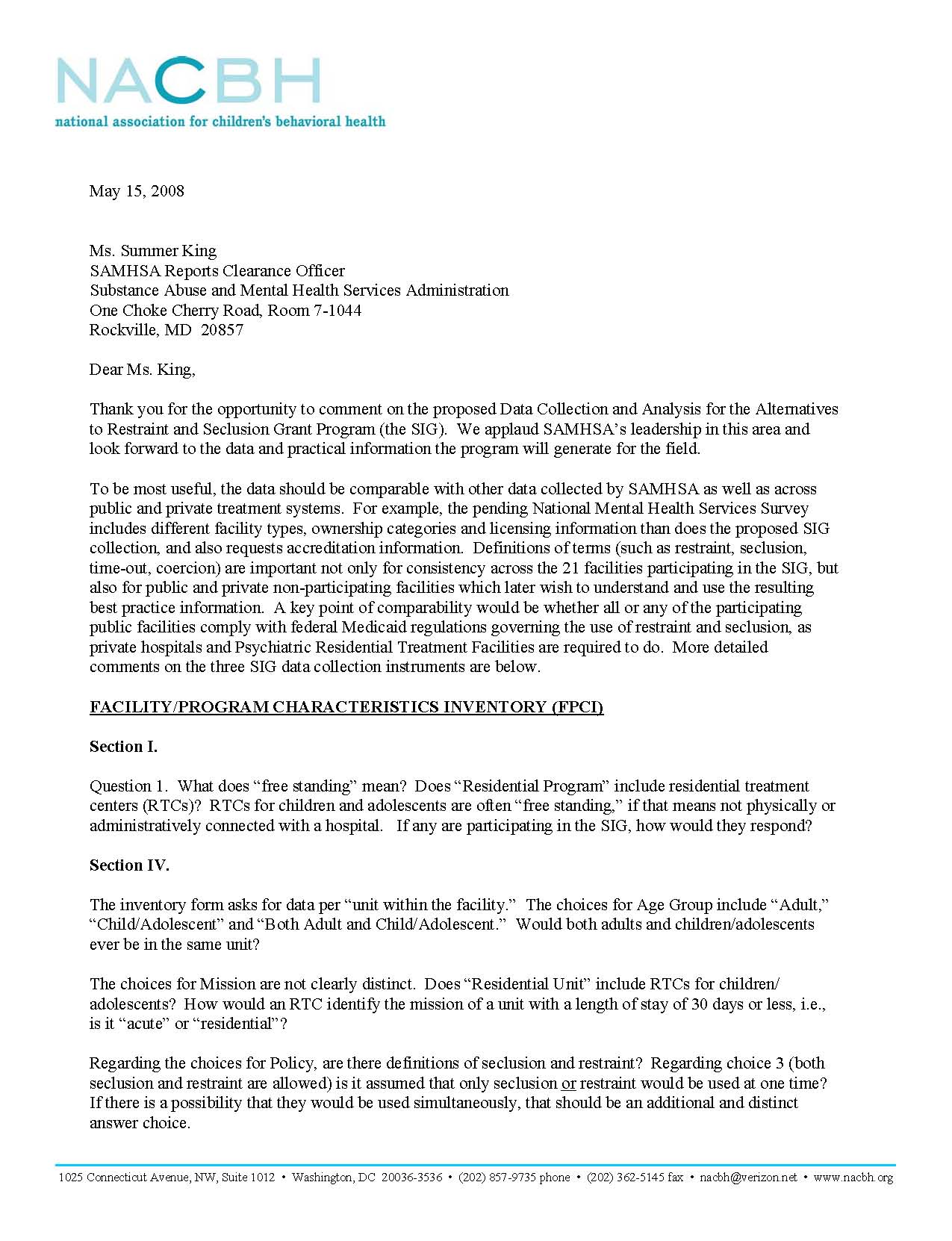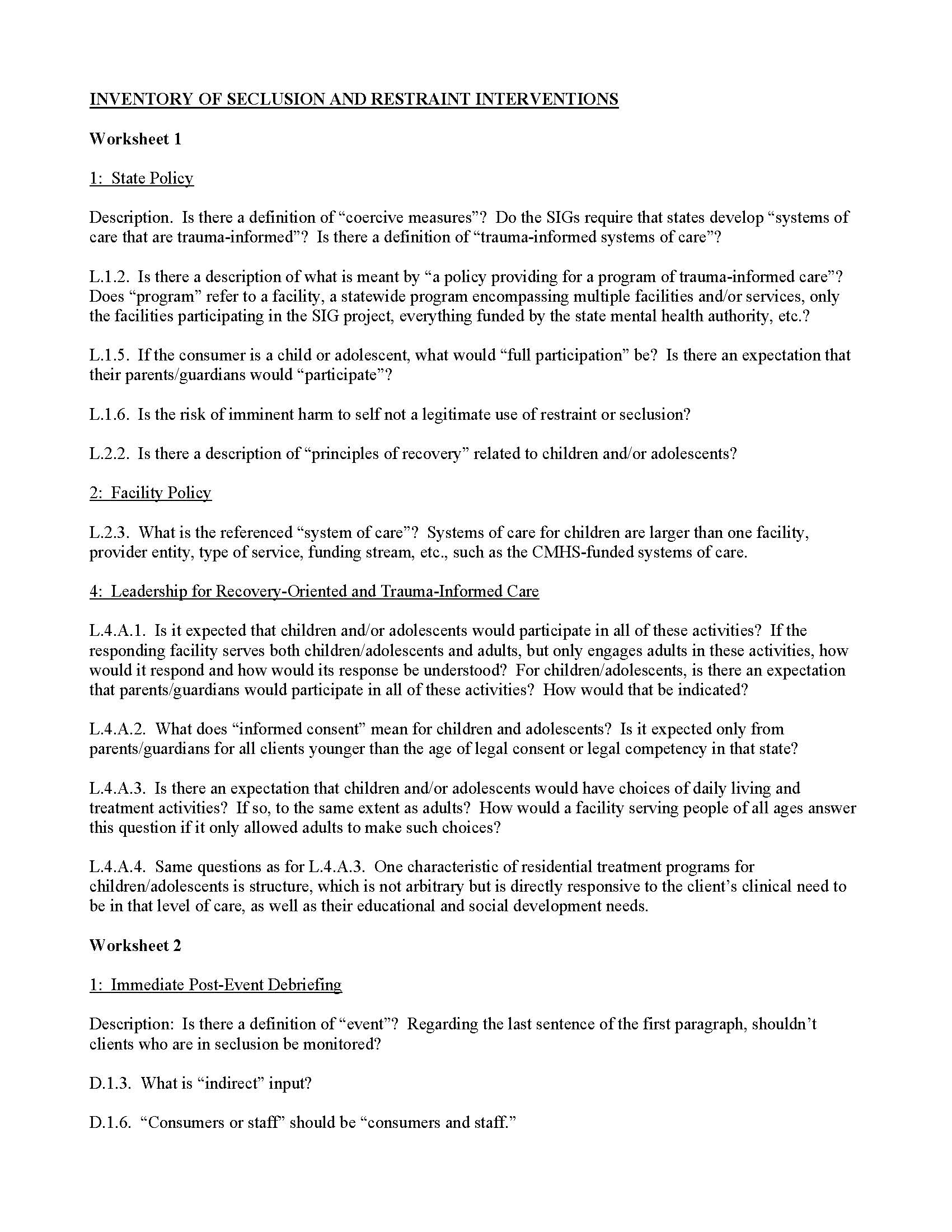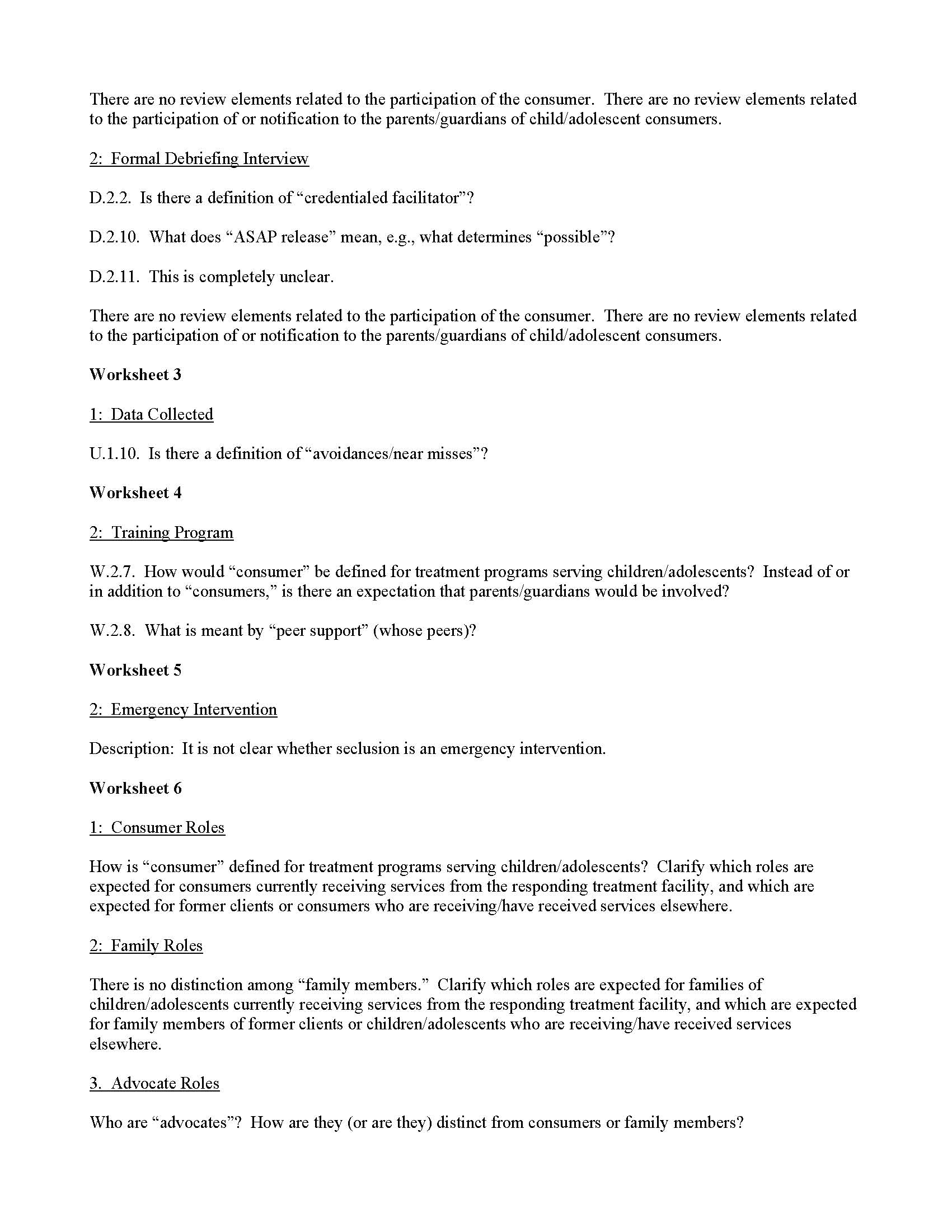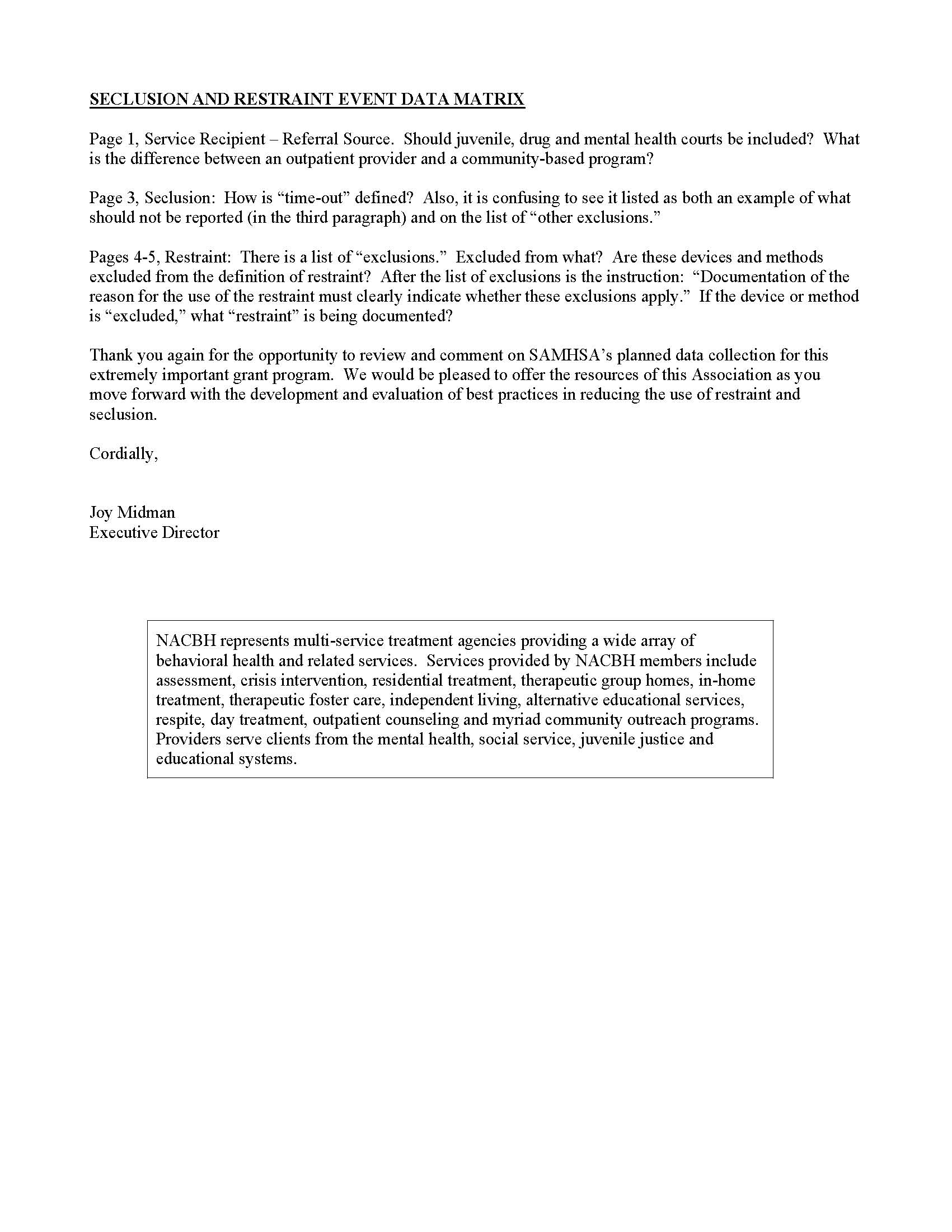Attachments J-K
Part 4 -- Attachments J-K.doc
Initiative to Reduce/Eliminate Seclusion and Restraint: State Incentive Grants and Coordinating Center
Attachments J-K
OMB: 0930-0271
ATTACHMENT J
60-Day
Federal Register
Notice Comments




Attachment K
Responses to 60-Day Federal Register Notice Comments
General Comment: To be most useful, the data should be comparable with other data collected by SAMHSA as well as across public and private treatment systems. For example, the pending National Mental Health Services Survey includes different facility types, ownership categories and licensing information than does the proposed SIG collection, and also requests accreditation information. Definitions of terms (such as restraint, seclusion, time-out, coercion) are important not only for consistency across the 21 facilities participating in the SIG, but also for public and private non-participating facilities which later wish to understand and use the resulting best practice information. A key point of comparability would be whether all or any of the participating public facilities comply with federal Medicaid regulations governing the use of restraint and seclusion, as private hospitals and Psychiatric Residential Treatment Facilities are required to do. More detailed comments on the three SIG data collection instruments are below.
General response:
The writer suggested that the data should be comparable with other data collected by SAMHSA and private/public treatment systems. Indeed, every effort has been made to use the same data collection instruments developed by SAMHSA for the previous Seclusion/Restraint Evaluation SIG (i.e., the FPCI and ISRRI surveys). Moreover, standardized definitions of seclusion and restraint have been created that are in accord with major federal guidelines (i.e., CMS). For other concepts, the field has not yet produced standardized definitions. This said, clear definitions have been produced for concepts most likely to trouble respondents. Please note: SAMHSA proceeds with the reasonable expectation that respondents will be familiar with the majority of the terms used since, prior to their completing the instruments, they will have received intensive on-site training from NTAC Consultants on the practices and concepts to which these terms refer. Moreover, for the Inventory of Seclusion and Restraint Reduction Interventions (ISRRI), respondents will have already completed the ISRRI on two prior occasions (using the instrument that was previously approved by OMB for the previous SAMHSA SIG). It is expected that, by the time of the third ISRRI administration, the vast majority of respondents’ questions regarding terms will already have been asked and addressed. SAMHSA thanks the writer for her comments and have made a number of additions/clarifications in response.
FACILITY/PROGRAM CHARACTERISTICS INVENTORY (FPCI)
Section I.
Question 1: What does “free standing” mean? Does “Residential Program” include residential treatment centers (RTCs)? RTCs for children and adolescents are often “free standing,” if that means not physically or administratively connected with a hospital. If any are participating in the SIG, how would they respond?
Response: Writer is technically correct – there are free standing residential treatment centers. However, the main point of distinction is between hospitals and residential programs. “Free Standing Psychiatric Facility” has been changed to “Free Standing Psychiatric Hospital.” SAMHSA knows of no psychiatric hospitals that are also residential, so this change should make the choices mutually exclusive.
Section IV.
Question 2: The inventory form asks for data per “unit within the facility.” The choices for Age Group include “Adult,” “Child/Adolescent” and “Both Adult and Child/Adolescent.” Would both adults and children/adolescents ever be in the same unit?
Response: Adults and children/adolescents would very rarely be on the same unit. However, there may be some very small units in rural areas that have to put children in adult units at times. Thus, this possibility is allowed for by including it as a possible answer choice, though it is not expected to be frequently endorsed.
Question 3: The choices for Mission are not clearly distinct. Does “Residential Unit” include RTCs for children/adolescents? How would an RTC identify the mission of a unit with a length of stay of 30 days or less, i.e., is it “acute” or “residential”?
Response: If a unit is residential, they would identify themselves as such by indicating “Residential Unit.” Residential units are often child/adolescent units and the definition clearly states the meaning of residential and gives examples. If a unit is non-residential, they would choose between the two other choices, “Acute Units” or “Continuing Care Units.”
Question 4: Regarding the choices for Policy, are there definitions of seclusion and restraint? Regarding choice 3 (both seclusion and restraint are allowed) is it assumed that only seclusion or restraint would be used at one time? If there is a possibility that they would be used simultaneously, that should be an additional and distinct answer choice.
Response: Yes, there are definitions for seclusion and restraint. Definitions of these terms have been added which are the same as those used in another evaluation instrument, the Seclusion and Restraint Event Data Matrix, and are based on CMS definitions. It is assumed that only seclusion or restraint would be used at any given time. In fact, it is understood that CMS does not allow both to be used together, a very dangerous practice. However, there could be a small number of facilities that do both together. Regardless, the current answer choice, “Both Seclusion and Restraint are Allowed,” is broad enough to capture both possibilities.
ISRRI
Worksheet One:
1. State Policy
Question 5: Description. Is there a definition of “coercive measures”? Do the SIGs require that states develop “systems of care that are trauma-informed”? Is there a definition of “trauma-informed systems of care”?
Response: SAMHSA is not aware of a formal definition of “coercive measures,” but they are generally assumed to be actions taken against the will of the consumer. The definition of “trauma-informed care” is well documented in the literature, and on SAMHSA’s and NTAC’s websites. Grantees are expected to be familiar with this concept. There is no mandate that states develop trauma-informed systems of care, but it is recommended under NTAC’s training.
Question 6: L.1.2. Is there a description of what is meant by “a policy providing for a program of trauma-informed care”? Does “program” refer to a facility, a statewide program encompassing multiple facilities and/or services, only the facilities participating in the SIG project, everything funded by the state mental health authority, etc.?
This question has been left open and flexible, so as to not limit the nature of potential interpretation. NTAC consultants are trained to evaluate whether a policy exists and will discuss/validate responder answers to this question.
Question 7: L.1.5. If the consumer is a child or adolescent, what would “full participation” be? Is there an expectation that their parents/guardians would “participate”?
Response: There is an expectation that child/adolescent “full participation” would include parents or guardians. The following has been added: “(If the consumer is a child/adolescent, this treatment planning process includes parents or guardians).”
Question 8: L.1.6. Is the risk of imminent harm to self not a legitimate use of restraint or seclusion?
Response: “Imminent harm to self” has been added. The question now reads: “A policy restricting the use of S/R to emergencies that reach the level of imminent risk of harm to self, staff or other consumers only.”
Question 9: L.2.2. Is there a description of “principles of recovery” related to children and/or adolescents?
Response: Additional descriptive text has been added to read: “A policy supporting the adoption of principles of recovery and/or resiliency.”
2. Facility Policy
Question 10: L.2.3. What is the referenced “system of care”? Systems of care for children are larger than one facility, provider entity, type of service, funding stream, etc., such as the CMHS-funded systems of care.
Response: System of care in this context merely refers to the system providing the inpatient or residential services.
4. Leadership for Recovery-Oriented and Trauma-Informed Care
Question 11: L.4.A.1. Is it expected that children and/or adolescents would participate in all of these activities? If the responding facility serves both children/adolescents and adults, but only engages adults in these activities, how would it respond and how would its response be understood? For children/adolescents, is there an expectation that parents/guardians would participate in all of these activities? How would that be indicated?
Response: It is expected that all children and adolescents participate up to their level of ability. Parents/guardians would be expected to participate if they were available.
Question 12: L.4.A.2. What does “informed consent” mean for children and adolescents? Is it expected only from parents/guardians for all clients younger than the age of legal consent or legal competency in that state?
Response: Informed consent would default to parents/guardians as appropriate. NTAC Consultants are aware of issues related to informed consent and will review these with respondents prior to completion of the survey. Progressive practice suggests that children should be informed about treatment and services being provided and that all efforts need to be made to include them and get their voluntary consent.
Question 13: L.4.A.3. Is there an expectation that children and/or adolescents would have choices of daily living and treatment activities? If so, to the same extent as adults? How would a facility serving people of all ages answer this question if it only allowed adults to make such choices?
Response: It is expected that children and adolescents would have same choices as adults.
Question 14: L.4.A.4. Same questions as for L.4.A.3. One characteristic of residential treatment programs for children/adolescents is structure, which is not arbitrary but is directly responsive to the client’s clinical need to be in that level of care, as well as their educational and social development needs.
Response: It is expected that children and adolescents would have same choices as adults. There is no evidence that "structure" has been well defined in the literature. Often this term is used to rationalize point and level systems, punishment and consequence based services, and rigid rules and coercive practices. Progressive practice suggests that all children and adults should be offered, and expected to participate in, meaningful, customized, and interesting treatment activities on a daily basis. NTAC Consultants are well versed in determining whether these kinds of activities are occurring.
Worksheet 2:
1. Immediate Post-Event Debriefing
Question 15: Description. Is there a definition of “event”? Regarding the last sentence of the first paragraph, shouldn’t clients who are in seclusion be monitored?
Response: An “event” is an event of seclusion and restraint. Text has been added to reflect this.
Question 16: D.1.3. What is “indirect” input?
Response: “Indirect input” means that the consumer has told another staff person, advocate or peer their experience to share with staff.
Question 17: D.1.6. “Consumers or staff” should be “consumers and staff.”
Response: The use of “or” does not seem problematic. It is of interest whether the post-event response included assessment of injury to either consumers or staff. The respondent would endorse the item if the post-event response included assessment of injury to at least one of these groups.
Question 18: There are no review elements related to the participation of the consumer. There are no review elements related to the participation of or notification to the parents/guardians of child/adolescent consumers.
Response: Another survey item has been added: “Consumer who experienced event provided personal comments on his/her experience in person or by proxy (peer or parent/guardian).”
2. Formal Debriefing Interview
Question 19: D.2.2. Is there a definition of “credentialed facilitator”?
Response: A “credentialed facilitator” is someone who has received formal training.
Question 20: D.2.10. What does “ASAP release” mean, e.g., what determines “possible”?
Response: “ASAP release” means that a consumer is released as soon as possible when he/she no longer meets criteria to be in seclusion or restraint.
Question 21: D.2.11. This is completely unclear.
Response: The following clarifications have been added in italics: “Release criteria are reasonable with the burden on staff, not consumer.”
Question 22: There are no review elements related to the participation of the consumer. There are no review elements related to the participation of or notification to the parents/guardians of child/adolescent consumers.
Response: Another survey item has been added: “Consumer who experienced event provided personal comments on his/her experience in person or by proxy (peer or parent/guardian).”
Worksheet 3
Data Collected
Question 23: U.1.10. Is there a definition of “avoidances/near misses”?
Response: It is assumed that most respondents know what this term means since its definition is covered during NTAC training. Respondents can ask if they do not.
Worksheet 4
2. Training Program
Question 24: W.2.7. How would “consumer” be defined for treatment programs serving children/adolescents? Instead of or in addition to “consumers,” is there an expectation that parents/guardians would be involved?
Response: “Consumer” has been revised to now read consumers/parents/guardians/peers.”
Question 25: W.2.8. What is meant by “peer support” (whose peers)?
Response: “Peer support” is a well known term of use in most settings. It is defined as the inclusion of the child or adult patient's peers who have experienced a diagnosis and treatment in a like facility; who now identifies as a person in recovery; and that works as a paid staff member or volunteer in a multiplicity of roles determined by the treatment setting. For children over 12, "peers" mean older children who have just transitioned out of adolescent treatment settings. The term in basically not used for children under 12.
Worksheet 5
Question 26: Description: It is not clear whether seclusion is an emergency intervention.
Response: Text has been added to read: “Policies and procedures for emergency seclusion and restraint interventions including:”
Worksheet 6
Consumer Roles:
Question 27: How is “consumer” defined for treatment programs serving children/adolescents? Clarify which roles are expected for consumers currently receiving services from the responding treatment facility, and which are expected for former clients or consumers who are receiving/have received services elsewhere.
Response: The term “consumer” in the description text has been changed to read: “The full and formal inclusion of consumers (or parents/guardians for child/adolescent facilities)…”
2, Family Roles:
Question 28: There is no distinction among “family members.” Clarify which roles are expected for families of children/adolescents currently receiving services from the responding treatment facility, and which are expected for family members of former clients or children/adolescents who are receiving/have received services elsewhere.
Response: No distinction between family members is needed in the description. It is expected that facilities will hire family members for certain roles whether the child/adolescent is in or out of the facility, as appropriate.
3. Advocates:
Question 29: Who are “advocates”? How are they (or are they) distinct from consumers or family members?
Response: Advocates are people who work in formal roles to improve service systems and who are either hired by the facility or who work for external agencies. External agencies that are most commonly involved include the State P&A organizations, the Federation of Families; NAMI, Mental Health America or grassroots local groups.
Seclusion and Restraint Event Data (SRED) Matrix
Question 30: Page 1, Service Recipient – Referral Source. Should juvenile, drug and mental health courts be included? What is the difference between an outpatient provider and a community-based program?
Response: The referral source categories have been revised (see below – italics are new text). “Juvenile, drug and mental health courts” would be included under the current category “Involuntary – Justice/Court System.” The category, “Voluntary – Community Based Program,” has been eliminated because it overlaps with the category, “Voluntary – Outpatient Provider (mental health/general medical).” Instead “Voluntary – Social Services/Community Residences” has been created. “Voluntary – Inpatient Provider” has been subdivided into “Voluntary – Inpatient Hospital” and “Voluntary – Inpatient Residential Treatment Center” to distinguish between inpatient hospital and residential treatment centers. All referral sources should now be more mutually exclusive. Respondents are now provided with examples of each category.
Service Recipient – Referral Source Categories (new text in italics):
Involuntary – Justice/Court System |
Involuntary - Civil Commitment |
Voluntary - Inpatient Hospital (mental health/general medical) |
Voluntary - Inpatient Residential Treatment Center |
Voluntary - Outpatient Provider (mental health/general medical) |
Voluntary - School/Academic/Employer |
Voluntary - Social Services/Community Residences |
Voluntary - Self/Friend/Guardian/Parent |
Other (specify types and provide column frequencies for each type) |
Question 31: Page 3, Seclusion: How is “time-out” defined? Also, it is confusing to see it listed as both an example of what should not be reported (in the third paragraph) and on the list of “other exclusions.”
Response: “Time-out” has been removed from the “Other Exclusions” list. The text, “voluntary time-out,” has been added to the text in the 3rd paragraph. Time-out refers to a behavior management technique that is part of an approved treatment program and may involve the separation of the resident from the group, in a non-locked setting, for the purpose of calming
Question 32: Pages 4-5, Restraint: There is a list of “exclusions.” Excluded from what? Are these devices and methods excluded from the definition of restraint? After the list of exclusions is the instruction: “Documentation of the reason for the use of the restraint must clearly indicate whether these exclusions apply.” If the device or method is “excluded,” what “restraint” is being documented?
Response: Devices and methods listed under the “exclusions” section are excluded from the definition of restraint and are not considered restraint events for the purposes of the current evaluation. Grantees are required to examine existing documentation (i.e., records/logs for a potential restraint event) to determine whether the exclusions apply. If any of the exclusions apply, then the event is not considered a restraint event and is not counted on the SRED Matrix. If none of the exclusions apply, then the event may be considered a restraint event provided it meets one of the valid restraint types.
| File Type | application/msword |
| File Title | SAMHSA/CMHS Initiative to Reduce/Eliminate Seclusion and Restraint: |
| Author | PWohlfor |
| Last Modified By | daniel falk |
| File Modified | 2008-07-08 |
| File Created | 2008-07-08 |
© 2025 OMB.report | Privacy Policy